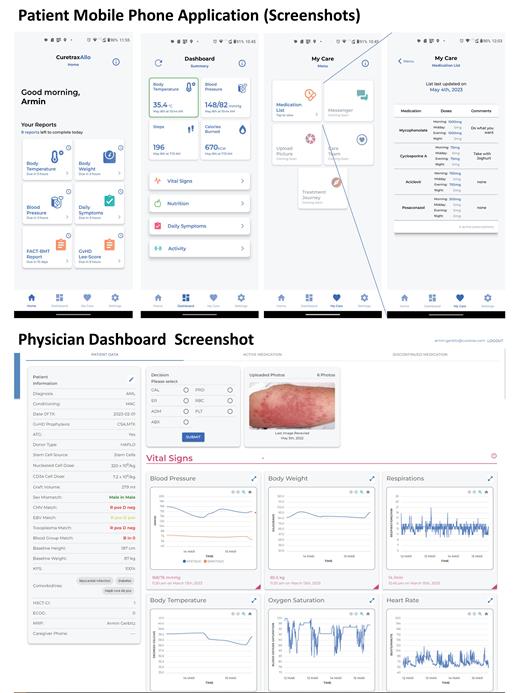Introduction: One of the major obstacles for early inpatient discharge after allogeneic stem cell transplantation (aSCT) is, aside from frailty and bloodwork required, the high risk for infections and the need for monitoring of graft versus host disease (GvHD). This requires frequent hospital visits which are often a challenge especially when travelling to hospitals imposes significant costs for the patient. Furthermore, structured data acquisition in the home care setting is missing.
Methods: We have developed a fully patient centered, easy to operate mobile phone application for aHSCT patients that allows for treatment specific symptom reporting. In combination with a wearable device (smart watch), a blood pressure monitor and a thermometer, this application incorporates online monitoring of all major vital signs in almost real time. The application currently captures more than 50 static and dynamic metrics relevant for aSCT and provides a photo function to capture skin images in a patient specific image library. Daily symptom reporting can be performed as often as necessary and data from wearable devices are obtained in very high frequency. Symptom reporting includes information on general wellbeing, nausea, oral mucositis, bowel movement frequency and consistency, information on oral calorie and fluid uptake, and it captures and calculates body surface areas affected by rash. All data are streamed in almost real time and displayed on a browser-based dashboard to the healthcare team. The user interface for the physician dashboard was developed using the React JavaScript library whereas the mobile application utilized React Native to enable Android and iOS applications. The collection, storage, and presentation of patient data via the physician dashboard is facilitated using various AWS technologies such as Lambda, S3 and Timestream. Data can be stored according to federal laws and regulations the software is operating in. Access to the dashboard is center-specific and secured by a dual verification process.
Summary: Daily symptom reporting by the patient is easy, comprehensive and can be completed within minutes. Data from wearable devices are obtained 24/7 at high frequency. All data are displayed on a dashboard to the corresponding physician with only a few minutes delay. The system captures vital signs (blood pressure, temperature, pulse, breathing rate, oxygen saturation, etc.) and GvHD related symptoms such as skin rash including body surface area affected, and frequency/volume of bowel movements. It provides information based on the patient's physical activity, food intake, fluid intake, sleeping patterns in a structured fashion. The physician's dashboard displays all transplant relevant static information like HLA match, conditioning regimen, type of immunosuppression, ABO incompatibility, serologies of patient and donor. It displays all data reported longitudinally and allows physicians to observe trends and developments providing interactive graphs on each metrics. It provides a medication plan that captures daily dosage, duration of treatment and calculates cumulative doses. Changes in medication and dosing will alert the patient on the mobile phone application. All data can be obtained in a structured fashion for research purposes by the participating institution.
Conclusion: This mobile phone application in combination with a wearable device allows for remote monitoring of patients after aHSCT. Its function is comprehensive and not only provides structured data, but allows for monitoring success of medical treatment. It is developed in a modular fashion that can be easily adapted to specific requirements in other cell therapies such CAR CD19, AML induction therapies or autologous SCT.
Disclosures
Gerbitz:Curetrax: Current equity holder in private company. Quirke:Curetrax: Current Employment. Abbas:Curetrax: Current equity holder in private company. Jayaraman:Curetrax: Current equity holder in private company.


This feature is available to Subscribers Only
Sign In or Create an Account Close Modal